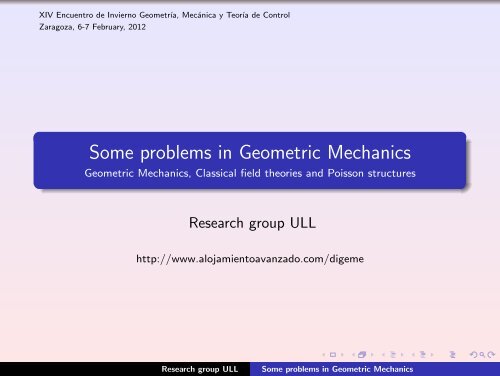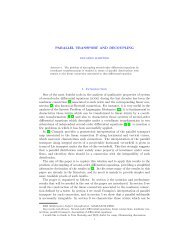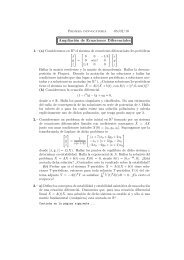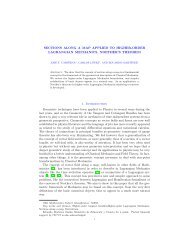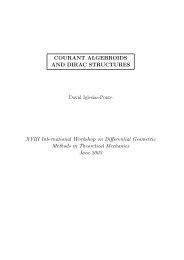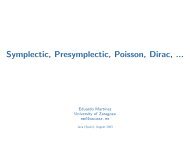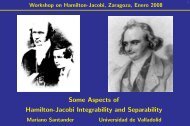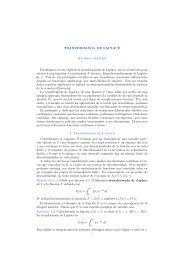Some problems in Geometric Mechanics - Geometric Mechanics ...
Some problems in Geometric Mechanics - Geometric Mechanics ...
Some problems in Geometric Mechanics - Geometric Mechanics ...
You also want an ePaper? Increase the reach of your titles
YUMPU automatically turns print PDFs into web optimized ePapers that Google loves.
XIV Encuentro de Invierno Geometría, Mecánica y Teoría de Control<br />
Zaragoza, 6-7 February, 2012<br />
<strong>Some</strong> <strong>problems</strong> <strong>in</strong> <strong>Geometric</strong> <strong>Mechanics</strong><br />
<strong>Geometric</strong> <strong>Mechanics</strong>, Classical field theories and Poisson structures<br />
Research group ULL<br />
http://www.alojamientoavanzado.com/digeme<br />
Research group ULL<br />
<strong>Some</strong> <strong>problems</strong> <strong>in</strong> <strong>Geometric</strong> <strong>Mechanics</strong>
General research proposal<br />
To study, from a geometric perspective, different methods to simplify how obta<strong>in</strong><br />
the trajectories of a mechanical system (subject or not to non-holonomic<br />
constra<strong>in</strong>ts)<br />
solutions of dynamic equations <strong>in</strong> first order classical field theories<br />
Several geometric methods<br />
Reduction Theory<br />
Hamilton-Jacobi Theory<br />
Invariant volumes<br />
<strong>Geometric</strong> <strong>in</strong>tegrators<br />
<strong>Geometric</strong> tools<br />
Poisson structures and generalizations<br />
Multisymplectic structures<br />
Research group ULL<br />
<strong>Some</strong> <strong>problems</strong> <strong>in</strong> <strong>Geometric</strong> <strong>Mechanics</strong>
Research l<strong>in</strong>es<br />
Reduction Theory<br />
Reduction of symplectic Lie algebroids<br />
Reduction of the Jacobi structure on the sphere of the dual bundle to a Lie algebroid endowed with<br />
a bundle metric<br />
Reduction and reconstruction of non-autonomous hamiltonian systems and symplectic pr<strong>in</strong>cipal<br />
R-bundles<br />
Introduction of the notion of a multi-Poisson structure as the Poisson version of a multisymplectic<br />
structure. Application to the reduction of first-order classical field theories<br />
Marsden-We<strong>in</strong>ste<strong>in</strong> multisymplectic reduction. Application to the reduction of first-order classical<br />
field theories<br />
Hamilton-Jacobi Theory<br />
Hamilton-Jacobi theory for hamiltonian systems with respect to l<strong>in</strong>ear Poisson structures<br />
Hamilton-Jacobi theory and complete <strong>in</strong>tegrability for (generalized) non-holonomic mechanical<br />
systems<br />
Hamilton-Jacobi theory for first-order classical field theories <strong>in</strong> the Lie algebroid sett<strong>in</strong>g<br />
Tulczyjew’s triple for first-order classical field theories <strong>in</strong> the Lie algebroid<br />
sett<strong>in</strong>g<br />
Study of <strong>in</strong>variant volume forms for non-holonomic mechanical systems<br />
Introduction of the <strong>in</strong>tr<strong>in</strong>sic notion of Poisson symmetric space<br />
Local description on discrete mechanics on Lie groupoids. The exact discrete<br />
lagrangian on a Lie groupoid<br />
Research group ULL<br />
<strong>Some</strong> <strong>problems</strong> <strong>in</strong> <strong>Geometric</strong> <strong>Mechanics</strong>
eduction theory<br />
Autonomous hamiltonian systems<br />
The configuration space:<br />
Q<br />
The phase space of momenta:<br />
T ∗ Q<br />
Hamiltonian function: H : T ∗ Q → R<br />
Structure: The canonical symplectic structure Ω Q ∈ Ω 2 (T ∗ Q)<br />
Hamiltonian vector field: H Ω Q<br />
H ∈ X(T ∗ Q), i Ω H Q<br />
Ω Q = dH<br />
H<br />
Solutions of Hamilton equations: <strong>in</strong>tegral curves of H Ω Q<br />
H<br />
In the presence of a group of symmetries<br />
⇓<br />
The system can be reduced to a system with less freedom degrees<br />
Reduction and reconstruction processes ⇒ the solutions of Hamilton equations<br />
dp<br />
dt = − ∂H<br />
∂q ,<br />
dq<br />
dt = ∂H<br />
∂p<br />
Research group ULL<br />
<strong>Some</strong> <strong>problems</strong> <strong>in</strong> <strong>Geometric</strong> <strong>Mechanics</strong>
ν ∈ g ∗ φ ν : G ν × J −1 (ν) → J −1 (ν), G ν = {g ∈ G/ Ad ∗ ν = ν}<br />
reduction theory<br />
Marsden-We<strong>in</strong>ste<strong>in</strong> reduction Theorem<br />
<strong>in</strong>gredients:<br />
(M, Ω) symplectic manifold<br />
φ : G × M → M a free and proper symplectic action of a Lie group G<br />
J : M → g ∗ an Ad ∗ -equivariant momentum map associated with φ<br />
ξ M = H Ω J ξ<br />
, J(φ g (x)) = Ad ∗ g −1 (J(x)), for any ξ ∈ g, x ∈ M<br />
⇓<br />
(J −1 (ν)/G ν, Ω ν) is a symplectic manifold<br />
π ∗ ν Ων = i ∗ ν Ω<br />
π ν : J −1 (ν) → J −1 (ν)/G ν,<br />
i ν : J −1 (ν) → M<br />
Research group ULL<br />
<strong>Some</strong> <strong>problems</strong> <strong>in</strong> <strong>Geometric</strong> <strong>Mechanics</strong>
eduction theory<br />
Marsden-We<strong>in</strong>ste<strong>in</strong> reduction Theorem by stages<br />
G = H 1 × H 2<br />
<strong>Some</strong> Applications<br />
Reduce by the subgroup H 1 at a time and then to reduce by H 2<br />
⇕<br />
Reduce by G<br />
underwater vehicle dynamics and stability (Leonard and Marsden [1997])<br />
Applications to compressible fluids (Holm and Kupershmidt [1983])<br />
H closed and normal subgroup of G<br />
Reduce by H and then by a group related with G/H<br />
⇕<br />
Reduce by G<br />
Research group ULL<br />
<strong>Some</strong> <strong>problems</strong> <strong>in</strong> <strong>Geometric</strong> <strong>Mechanics</strong>
two applications of symplectic reduction<br />
cotangent reduction<br />
Kirillov-Kostant-Souriau Theorem<br />
Research group ULL<br />
<strong>Some</strong> <strong>problems</strong> <strong>in</strong> <strong>Geometric</strong> <strong>Mechanics</strong>
cotangent reduction<br />
(M, Ω) = (T ∗ Q, Ω Q )<br />
φ : G × Q → Q a free and proper action<br />
T ∗ φ : G × T ∗ Q → T ∗ Q free and proper action<br />
J : T ∗ Q → g ∗ Ad ∗ -equivariant hamiltonian momentum map<br />
J(α q)(ξ) = α q(ξ Q (q))<br />
ν ∈ g ∗<br />
⇓<br />
(J −1 (ν)/G ν, (Ω Q ) ν) reduced symplectic manifold<br />
+<br />
α ν ∈ Ω 1 (Q)<br />
G ν-<strong>in</strong>variant 1-form with values <strong>in</strong> J −1 (ν)<br />
⇓<br />
ϕ αν : (J −1 (ν)/G ν, (Ω Q ) ν) → (T ∗ (Q/G ν), Ω Q/Gν − B αν ) embedd<strong>in</strong>g<br />
ϕ αν<br />
is a symplectomorphism ⇐⇒ g = g ν<br />
Research group ULL<br />
<strong>Some</strong> <strong>problems</strong> <strong>in</strong> <strong>Geometric</strong> <strong>Mechanics</strong>
Kirillov-Kostant-Souriau Theorem<br />
Kirillov-Kostant-Souriau Theorem<br />
The coadjo<strong>in</strong>t orbits <strong>in</strong> the dual space of the Lie algebra of a Lie group admit a<br />
symplectic structure<br />
<strong>in</strong>gredients<br />
G a Lie group with Lie algebra g<br />
The free and proper action l : G × G → G,<br />
The symplectic manifold (T ∗ G ∼ = G × g ∗ , Ω G )<br />
The symplectic action T ∗ l : G × G × g ∗ → G × g ∗<br />
l(g, h) = l g (h) = gh.<br />
The Ad ∗ -equivariant momentum map J T ∗G : G × g ∗ → g ∗<br />
(J T ∗G ) −1 (ν) = {(g, Ad ∗ g ν)|g ∈ G} ≃ G<br />
⇓ Marsden-We<strong>in</strong>ste<strong>in</strong> symplectic reduction theorem<br />
(J T ∗G ) −1 (ν)/G ν ∼ = G/Gν ≃ O ν<br />
Research group ULL<br />
<strong>Some</strong> <strong>problems</strong> <strong>in</strong> <strong>Geometric</strong> <strong>Mechanics</strong>
Poisson reduction<br />
<strong>in</strong>gredients<br />
Poisson manifold (M, {·, ·})<br />
φ : G × M → M a free and proper canonical Poisson action<br />
⇓<br />
M/G a Poisson manifold<br />
{f 1 , f 2 } r ◦ π = {f 1 ◦ π, f 2 ◦ π} ,<br />
where π : M → M/G is the canonical projection and f 1 , f 2 ∈ C ∞ (M/G)<br />
M = T ∗ Q<br />
T ∗ φ : G × T ∗ Q → T ∗ Q with φ : G × M → M free and proper action<br />
T ∗ Q/G → Q/G l<strong>in</strong>ear Poisson manifold<br />
Q = G and φ = l : G × G → G<br />
⇓<br />
the symplectic leaves of T ∗ G/G are the coadjo<strong>in</strong>t orbits<br />
Research group ULL<br />
<strong>Some</strong> <strong>problems</strong> <strong>in</strong> <strong>Geometric</strong> <strong>Mechanics</strong>
L<strong>in</strong>ear Poisson structures on a vector bundle<br />
To extend the reduction process for l<strong>in</strong>ear Poisson structures on vector bundles<br />
A → M vector bundle<br />
{Λ A ∗ ∈ V 2 (A ∗ ) l<strong>in</strong>ear Poisson structure on A ∗ } ↔ {([[·, ·]], ρ) Lie algebroid structure on A}<br />
[[·, ·]] : Γ(A) × Γ(A) → Γ(A) Lie bracket<br />
ρ : A → TM vector bundle morphism (anchor map)<br />
[[X , fY ]] = f [[X , Y ]] + ρ(X )(f )Y , ∀X , Y ∈ Γ(A), ∀f ∈ C ∞ (M)<br />
⇓<br />
(A, [[·, ·]], ρ) Lie algebroid<br />
Schouten bracket [·, ·] : Γ(∧ p A) × Γ(∧ p′ A) → Γ(∧ p+p′ −1 A)<br />
The differential of A d A : Γ(∧ k A ∗ ) → Γ(∧ k A ∗ )<br />
Research group ULL<br />
<strong>Some</strong> <strong>problems</strong> <strong>in</strong> <strong>Geometric</strong> <strong>Mechanics</strong>
Symplectic Lie algebroids<br />
(A → M, [[·, ·]], ρ) Lie algebroid of rank 2n + Ω ∈ Γ(∧ 2 A ∗ )<br />
d A Ω = 0, (Ω) n ≠ 0<br />
⇓<br />
M Poisson manifold<br />
example:<br />
(τ : A → M, [[·, ·]], ρ) Lie algebroid of rank n<br />
T A A ∗ → A ∗ vector bundle<br />
(T A A ∗ ) a ∗ = {(a, v) ∈ A τ ∗ (a ∗ ) × T a ∗ A ∗ /ρ(a) = T a ∗ τ ∗ (v)}<br />
T A A ∗ → A ∗ is a Lie algebroid of rank 2n ≡ the cover of fiberwise l<strong>in</strong>ear Poisson manifold<br />
λ A ∈ Γ((T A A ∗ ) ∗ ), Ω A = −d T A A ∗ λ A<br />
⇓<br />
T A A ∗ → A ∗ is a symplectic Lie algebroid<br />
Research group ULL<br />
<strong>Some</strong> <strong>problems</strong> <strong>in</strong> <strong>Geometric</strong> <strong>Mechanics</strong>
eduction of symplectic lie algebroids<br />
Reduction process for Lie algebroids<br />
Reduction process for symplectic Lie algebroids <strong>in</strong> the presence of a momentum<br />
map<br />
Application to the symplectic cover of a fiberwise l<strong>in</strong>ear Poisson manifold<br />
J.C. Marrero, E. Padrón, M. Rodríguez-Olmos: Reduction of a symplectic Lie algebroid with momentum map and<br />
its application to fiberwise l<strong>in</strong>ear poisson structures Prepr<strong>in</strong>t 2011.<br />
Research group ULL<br />
<strong>Some</strong> <strong>problems</strong> <strong>in</strong> <strong>Geometric</strong> <strong>Mechanics</strong>
eduction of lie algebroids<br />
<strong>in</strong>gredients<br />
(A → M, [[·, ]], ρ, Ω) symplectic Lie algebroid<br />
Φ : G × A → A action by complete lifts associated with φ : G × M → M<br />
ψ : g → Γ(A) Lie algebra anti-morphism such that Φ ∗ : G × A ∗ → A ∗ action by Poisson automorphisms<br />
ξ A ∗ = H Ω̂ψ(ξ)<br />
⇓<br />
Φ T : TG × A → A an aff<strong>in</strong>e action of TG ∼ = G × g over A<br />
Φ T ((g, ξ), a x ) = Φ g (a x + ψ(ξ)(x))<br />
⇓<br />
A/TG is a Lie algebroid over M/G and ˜π : A → A/TG is a Lie algebroid epimorphism<br />
Research group ULL<br />
<strong>Some</strong> <strong>problems</strong> <strong>in</strong> <strong>Geometric</strong> <strong>Mechanics</strong>
Reduction of symplectic Lie algebroids<br />
<strong>in</strong>gredients<br />
(A → M, [[·, ·]], ρ, Ω) symplectic Lie algebroid<br />
Φ : G × A → A action by complete lifts<br />
J : M → g ∗ momentum map<br />
Adg−1 ∗ (J(x)) = J(φg (x)), ∀x ∈ M, ∀g ∈ G<br />
Φ ∗ g (Ω) = Ω and i ψ(ξ) Ω = d A J ξ , for all g ∈ G and ξ ∈ g<br />
⇓<br />
J T : A → g ∗ × g ∗ ,<br />
J T (a) = ((TJ ◦ ρ)(a), J(τ(a)))<br />
TG × A → A aff<strong>in</strong>e action<br />
(A ν = (J T ) −1 (0, ν)/TG ν → J −1 (ν)/G ν, Ω ν) symplectic Lie algebroid<br />
Research group ULL<br />
<strong>Some</strong> <strong>problems</strong> <strong>in</strong> <strong>Geometric</strong> <strong>Mechanics</strong>
the particular case of T A A ∗<br />
<strong>in</strong>gredients<br />
(T A A ∗ → A ∗ , Ω A ) symplectic Lie algebroid<br />
Φ : G × A → A action by complete lifts with respect to ψ : g → Γ(A)<br />
⇓<br />
(Φ, T Φ ∗ ) : G × T A A ∗ → T A A ∗<br />
ψ T : g → Γ(T A A ∗ )<br />
J A ∗ : A ∗ → g ∗ hamiltonian momentum map<br />
J A ∗ (α x )(ξ) = α x (ψ(ξ)(x))<br />
((T A A ∗ ) ν, Ω ν) → (T A 0,ν<br />
A ∗ 0,ν , Ω A 0,ν<br />
− (pr 1 ) ∗ B ν) symplectic Lie algebroid embedd<strong>in</strong>g<br />
isomorphism if and only if g = g ν<br />
A 0,ν = A/TG ν → M/G ν<br />
Research group ULL<br />
<strong>Some</strong> <strong>problems</strong> <strong>in</strong> <strong>Geometric</strong> <strong>Mechanics</strong>
Reduction of symplectic Lie algebroids<br />
new objectives:<br />
To apply this reduction process to new examples<br />
Bundle version reduction of the symplectic cover of a fiberwise l<strong>in</strong>ear Poisson<br />
manifold<br />
Reduction by stages of symplectic Lie algebroids<br />
Research group ULL<br />
<strong>Some</strong> <strong>problems</strong> <strong>in</strong> <strong>Geometric</strong> <strong>Mechanics</strong>
L<strong>in</strong>ear Poisson manifolds on a vector bundle with a fiber metric<br />
The cotangent sphere bundle of a Riemannian manifold (Q, g) of dimension n<br />
S n−1 (T ∗ Q) = T ∗ 1 Q = {α ∈ T ∗ Q/g(α, α) = 1} → Q<br />
i S n−1 (T ∗ Q)<br />
: S n−1 (T ∗ Q) → T ∗ Q,<br />
λ ∈ Ω 1 (T ∗ Q) Liouville 1-form<br />
θ = −i ∗ S n−1 (T ∗ Q) (λ) ∈ Ω1 (S n−1 (T ∗ Q))<br />
θ ∧ (dθ) n is a volume form on T ∗ Q<br />
Unit sphere of a real Lie algebra with scalar product (g, [·, ·], < ·, · >) of dimension n<br />
S n−1 (g ∗ ) = {α ∈ g ∗ / < α, α >= 1}<br />
Λ g ∗ Lie-Poisson structure on g ∗<br />
¯Λ = Λ g ∗ − ∆ g ∗ ∧ i αg ∗ Λ g ∗ ∈ V2 (g ∗ ), Ē = i αg ∗ Λ g ∗ ∈ X(g∗ ),<br />
(g ∗ , (¯Λ, Ē)) Jacobi manifold<br />
[¯Λ, ¯Λ] = 2Ē ∧ ¯Λ, [Ē, ¯Λ] = 0<br />
⇓<br />
(S n−1 (g ∗ ), (¯Λ |S n−1 (g ∗ )<br />
, Ē |S n−1 (g ∗ )<br />
)) Jacobi manifold<br />
Research group ULL<br />
<strong>Some</strong> <strong>problems</strong> <strong>in</strong> <strong>Geometric</strong> <strong>Mechanics</strong>
(A ∗ , Λ A ∗ ) l<strong>in</strong>ear Poisson manifold with τ : A → M + g fiber bundle metric on A ∗<br />
⇓<br />
S n−1 (A ∗ ) → Q Jacobi manifold ?<br />
T A S n−1 (A ∗ )<br />
T A i<br />
✲<br />
T<br />
A A<br />
∗<br />
❄<br />
S n−1 (A ∗ )<br />
i<br />
✲<br />
❄<br />
T A S n−1 (A ∗ ) → S n−1 (A ∗ ) subalgebroid of T A A ∗ → A ∗<br />
A<br />
∗<br />
θ A = −(T A i) ∗ (λ A ) contact structure<br />
Ω A = −d T A A ∗ λ A symplectic structure<br />
θ A ∧ (d A θ A ) n ≠ 0<br />
⇓<br />
S n−1 (A ∗ ) Jacobi manifold<br />
A ∗ l<strong>in</strong>ear Poisson manifold<br />
i ∗ T A A ∗ = Ti(T A S 1 (A ∗ )) ⊕ i ∗ (< ∆ >), ∆ ∈ Γ(T A A ∗ )<br />
Research group ULL<br />
<strong>Some</strong> <strong>problems</strong> <strong>in</strong> <strong>Geometric</strong> <strong>Mechanics</strong>
The Jacobi structure on the sphere of a l<strong>in</strong>ear Poisson manifold on a vector<br />
bundle with fiber metric<br />
D. Ch<strong>in</strong>ea, J.C. Marrero, E. Padrón: The Jacobi structure on the sphere of a l<strong>in</strong>ear Poisson manifold on a vector<br />
bundle with fiber metric, work <strong>in</strong> progress<br />
New Objetives<br />
Give an explicit description of the Jacobi structure on S n−1 (A ∗ ) for known<br />
examples of Lie algebroids A<br />
Give a contact reduction procedure for contact Lie algebroids <strong>in</strong> the presence of<br />
momentum map, apply this result to the particular case of T S n−1 (A ∗ )<br />
Under certa<strong>in</strong> regularity conditions, study the manifold S n−1 (A ∗ )/E Is it aga<strong>in</strong> a<br />
Poisson manifold?<br />
R 2n symplectic manifold ⇒ S n−1 (R 2n ) contact manifold ⇒ S n−1 (R 2n )/E ∼ = CP<br />
n−1 symplectic manifold<br />
A ∗ l<strong>in</strong>ear Poisson manifold ⇒ S n−1 (A ∗ ) Jacobi manifold ⇒ S n−1 (A ∗ )/E Poisson manifold<br />
Research group ULL<br />
<strong>Some</strong> <strong>problems</strong> <strong>in</strong> <strong>Geometric</strong> <strong>Mechanics</strong>
Hamiltonian Systems<br />
Non-autonomous hamiltonian systems<br />
The configuration space:<br />
The phase space of momenta:<br />
extended version: T ∗ M<br />
π : M → R surjective submersion<br />
restricted version: V ∗ π V x π = T x π for all x ∈ M<br />
Structure: µ π : T ∗ M → V ∗ M<br />
µ π : T ∗ M → V ∗ π is a pr<strong>in</strong>cipal R-bundle<br />
ψ π : R × T ∗ M → T ∗ M,<br />
ψ π(s, α x ) = α x + sπ ∗ (dt)(x)<br />
ψ π is symplectic<br />
µ : (A, Ω) → V is a symplectic pr<strong>in</strong>cipal R-bundle if Ω is a symplectic structure on A<br />
such that the associated pr<strong>in</strong>cipal action ψ : R × A → A is symplectic<br />
µ : (A, Ω) → (V ∼ = A/R, Λ) Poisson morphism<br />
Research group ULL<br />
<strong>Some</strong> <strong>problems</strong> <strong>in</strong> <strong>Geometric</strong> <strong>Mechanics</strong>
canonical actions and momentum maps<br />
φ : G × A → A is a canonical action on the symplectic pr<strong>in</strong>cipal R-bundle<br />
µ : (A, Ω) → V<br />
φ is a symplectic action<br />
φ g ◦ ψ s = ψ s ◦ φ g<br />
for any g ∈ G, s ∈ R<br />
the 1-form ζ µ = i Zµ Ω is basic with respect to φ, i.e ζ µ(ξ A ) = 0 for any ξ ∈ g<br />
J : A → g ∗ Ad ∗ -equivariant momentum map for φ<br />
⇓<br />
+<br />
φ V : G × V → V Poisson action<br />
φ V (g, v) = µ(φ g (a))for any g ∈ G, v ∈ V<br />
J V : V → g ∗ Ad ∗ -equivariant momentum map for φ v<br />
J V (v) = J(a), with a ∈ µ −1 (v)<br />
Research group ULL<br />
<strong>Some</strong> <strong>problems</strong> <strong>in</strong> <strong>Geometric</strong> <strong>Mechanics</strong>
eduction process of symplectic R-pr<strong>in</strong>cipal bundle<br />
<strong>in</strong>gredients<br />
µ : (A, Ω) → V symplectic R-pr<strong>in</strong>cipal bundle<br />
φ : G × A → A canonical action with φ V : G × V → V is free and proper<br />
J : A → g ∗ Ad ∗ -equivariant momentum map<br />
ν ∈ g ∗ ⇓Marsden-We<strong>in</strong>ste<strong>in</strong> Th.<br />
⇓Poisson reduction Th.<br />
(A ν = J −1 (ν)/G ν, Ω ν) V ν = (J V ) −1 (ν)/G ν<br />
⇓<br />
µ ν : (A ν, Ω ν) → V ν is a symplectic pr<strong>in</strong>cipal R-bundle<br />
{·, ·} ν Poisson on V ν ≡ the Poisson bracket <strong>in</strong>duced by µ ν : A ν → V ν<br />
Research group ULL<br />
<strong>Some</strong> <strong>problems</strong> <strong>in</strong> <strong>Geometric</strong> <strong>Mechanics</strong>
standard symplectic pr<strong>in</strong>cipal R-bundle reduction theorem<br />
φ : G × M → M free and proper action<br />
π : M → R a G-<strong>in</strong>variant surjective submersion<br />
ν ∈ g ∗<br />
λ ν ∈ Ω 1 (M) a G ν-<strong>in</strong>variant 1-form with values <strong>in</strong> J −1<br />
ν (ν ′ )<br />
Then ˜π ν : M/G ν → R is a surjective submersion and there is a symplectic pr<strong>in</strong>cipal<br />
R-bundle embedd<strong>in</strong>g<br />
((T ∗ M) ν, (Ω M ) ν)<br />
ϕ λν<br />
(T ∗ (M/G ν), Ω M/Gν − B λν )<br />
(µ π) ν<br />
<br />
µ ˜πν<br />
<br />
(V ∗ π) ν<br />
ϕ V λν<br />
V ∗˜π ν<br />
B λν ∈ Ω 2 (T ∗ (M/G ν )) magnetic term associated with λ ν<br />
ϕ λν<br />
is a symplectic pr<strong>in</strong>cipal R-bundle isomorphism ⇔ g = g ν<br />
Research group ULL<br />
<strong>Some</strong> <strong>problems</strong> <strong>in</strong> <strong>Geometric</strong> <strong>Mechanics</strong>
Kirillov-Kostant-Souriau theorem (version for pr<strong>in</strong>cipal G-bundle<br />
with base space R<br />
<strong>in</strong>gredients<br />
φ : G × M → M free and proper action with pr<strong>in</strong>cipal G-bundle projection<br />
π : M → M/G ≃ R<br />
⇓<br />
T ∗ φ : G ×T ∗ M → T ∗ M + Ad ∗ -equivariant momentum map J : T ∗ M → g ∗<br />
⇓<br />
µ π : T ∗ M → V ∗ π be the standard symplectic R-bundle<br />
ν ∈ g ∗<br />
⇓ symplectic pr<strong>in</strong>cipal R-bundle reduction theorem<br />
(µ π) ν : ((T ∗ M) ν, (Ω M ) ν) → (V ∗ π) ν ∼ = M/Gν<br />
The Poisson structure on M/G ν<br />
The space of orbits M/G ν of the action of G ν on M admits a Poisson structure<br />
{·, ·} M/Gν and the symplectic leaf of M/G ν pass<strong>in</strong>g through the po<strong>in</strong>t [x] is<br />
symplectomorphic to O ν<br />
Research group ULL <strong>Some</strong> <strong>problems</strong> <strong>in</strong> <strong>Geometric</strong> <strong>Mechanics</strong>
Non-autonomous hamiltonian systems<br />
I. Lacirasella, J. C. Marrero, E. Padrón: Reduction of symplectic R-bundles, Prepr<strong>in</strong>t 2012, arXiv:1201.4690<br />
To develop the bundle version of the reduction of the standard symplectic<br />
pr<strong>in</strong>cipal R-bundle<br />
To reconstruct the dynamics of a non-autonomous hamiltonian systems on a<br />
symplectic pr<strong>in</strong>cipal R-bundle from reduced dynamics.<br />
To study the reduction theory by stages of a symplectic pr<strong>in</strong>cipal R-bundle<br />
Research group ULL<br />
<strong>Some</strong> <strong>problems</strong> <strong>in</strong> <strong>Geometric</strong> <strong>Mechanics</strong>
multisymplectic geometry<br />
Classical field theories ⇔ multisymplectic formulation<br />
multisymplectic structure Ω ∈ Ω k (M), dΩ = 0<br />
i X Ω = 0 ⇒ X = 0,<br />
∀X ∈ X(M)<br />
example<br />
M = ∧ k T ∗ Q<br />
λ M (α)(X 1 , . . . , X k ) = α(T π(X 1 ), . . . , T π(X k )),<br />
π : ∧ k T ∗ Q → Q.<br />
Ω M = −dλ M es una forma multisimpléctica en Q<br />
Research group ULL<br />
<strong>Some</strong> <strong>problems</strong> <strong>in</strong> <strong>Geometric</strong> <strong>Mechanics</strong>
polisympletic structures<br />
k-polisymplectic structure on M<br />
⇕<br />
(ω 1 , . . . , ω k ) closed non-degenerate 2-forma R k -valued<br />
k∑<br />
¯ω = ω A ⊗ e A<br />
A=1<br />
{e 1 , . . . , e k } canonical base of R k .<br />
Example 1:<br />
(T 1 k )∗ Q := T ∗ Q⊕ (k . . . ⊕T ∗ Q,<br />
ω A = (π k,A<br />
Q )∗ ω,<br />
ω canonical symplectic form on T ∗ Q and π k,A<br />
Q : T ∗ Q⊕ . (k . . ⊕T ∗ Q → T ∗ Q the<br />
projection<br />
((T 1 k )∗ Q, ω 1 , . . . , ω k ) polisympletic manifold<br />
Research group ULL<br />
<strong>Some</strong> <strong>problems</strong> <strong>in</strong> <strong>Geometric</strong> <strong>Mechanics</strong>
polisympletic structures<br />
G a Lie group and g its Lie algebra<br />
g ∗ × (k . . . ×g ∗<br />
Coad k : G × g ∗ × (k . . . ×g ∗ → g ∗ × (k . . . ×g ∗<br />
(g, ν 1 , . . . , ν k ) ↦→ (Coad (g, ν 1 ), . . . , Coad (g, ν k ))<br />
(ν 1 , . . . , ν k ) ∈ g ∗ × (k . . . ×g ∗ coadjo<strong>in</strong>t k-orbits<br />
O (ν1 ,...,ν k ) = {Coad k (g, ν 1 , . . . , ν k ) | g ∈ G} ,<br />
is a polisymplectic manifold<br />
ω A ν : = (pr A ) ∗ ω νA ,<br />
pr A : : O (ν1 ,...,ν k ) → O νA , (ν 1 , . . . , ν k ), ↦→ ν A canonical projection and ω νA sympletic<br />
form of O νA<br />
Research group ULL <strong>Some</strong> <strong>problems</strong> <strong>in</strong> <strong>Geometric</strong> <strong>Mechanics</strong>
We return to the symplectic and Poisson cases<br />
Ω symplectic structure<br />
⇕<br />
♭ ω : TM → T ∗ M, ♭ ω(v x ) = i vx ω x vector bundle isomorphism<br />
♭ ω([X , Y ]) = L X ♭ ω(Y ) − L Y ♭ ω(X ) − d(♭ ω(X )(Y )), ∀X , Y ∈ X(M)<br />
(M, Λ) Poisson manifold<br />
⇓<br />
♯ Λ : T ∗ M → TM, ♯ Λ (α x ) = i αx Λ<br />
D = Im♯ Λ <strong>in</strong>tegrable distribution whose leaves are symplectic manifolds<br />
(T ∗ M, [[·, ·]], ♯ Λ ) Lie algebroid<br />
[[α, β]] = L ♯Λ (α)β − L ♯Λ (β)α − d(β(♯ Λ (α)))<br />
{ ♯Λ : T<br />
Λ Poisson structure ⇔<br />
∗ → TM vector bundle homomorphism<br />
♯ Λ ([[α, β]]) = [♯ Λ (α), ♯ Λ (β)] ∀α, β ∈ Ω 1 (M)<br />
Research group ULL<br />
<strong>Some</strong> <strong>problems</strong> <strong>in</strong> <strong>Geometric</strong> <strong>Mechanics</strong>
polisympletic structures<br />
¯ω k-poly-symplectic structure on M<br />
⇕<br />
♭ ω : TM → ♭ ω (TM) ⊆ (Tk 1 )∗ M := T ∗ M⊕ . k . . ⊕T ∗ M ♭ ω (v x ) = (i vx (ωx 1 ), . . . , ivx (ωk x ))<br />
isomorphism vector bundle from TM to a sub-bundle of T ∗ M⊕ . k . . ⊕T ∗ M<br />
Skew-symmetry:<br />
♭ ω (v x )(v x ) = (0, . . . , 0)<br />
(v x ∈ T x M, x ∈ M).<br />
Non degenerate condition: ♭ ω vector bundle monomorphism<br />
Ker (♭ ω ) = {0}<br />
Integrability condition:<br />
♭ ω ([X , Y ]) = L X ♭ ω (Y ) − L Y ♭ ω (X ) − d(♭ ω (X )(Y )),<br />
X , Y ∈ X(M)<br />
Research group ULL<br />
<strong>Some</strong> <strong>problems</strong> <strong>in</strong> <strong>Geometric</strong> <strong>Mechanics</strong>
Poli-Poisson structures<br />
(S, ♯) poli-Poisson structure<br />
⇕<br />
S vector sub-bundle of (Tk 1)∗ M<br />
♯ : S → TM vector bundle morphism<br />
Skew-symmetry: α i (♯(α)) = 0, α = (α 1 , . . . , α k ), i ∈ {1, . . . , k}<br />
Non degenerate condition: If α(♯(β)) = 0 ∀β ∈ S ⇒ ♯(α) = 0<br />
Integrability condition: α, β ∈ Γ(S)<br />
(<br />
)<br />
[♯(α), ♯(β)] = ♯ L ♯(α) β − L ♯(β) α − d(β(♯(α)))<br />
Research group ULL<br />
<strong>Some</strong> <strong>problems</strong> <strong>in</strong> <strong>Geometric</strong> <strong>Mechanics</strong>
polisympletic structures<br />
Polisymplectic manifold ⇒ Poli-Poisson manifold<br />
S = ♭ ω (TM) and ♯ = ♭ −1<br />
ω<br />
Poli-Poisson manifold of order k = 1 ≡ Poisson manifold<br />
properties:<br />
(M, S, ♯) poli-Poisson manifold⇒ D = Im♯ is <strong>in</strong>tegrable<br />
L a leaf of F D ⇒ polisymplectic structure<br />
Research group ULL<br />
<strong>Some</strong> <strong>problems</strong> <strong>in</strong> <strong>Geometric</strong> <strong>Mechanics</strong>
polisympletic reduction<br />
<strong>in</strong>gredients:<br />
(M, ¯ω = (ω 1 , . . . , ω k )) a poly-simplectic manifold<br />
Φ : G × M → M a proper and free action such that Φ ∗ g ω i = ω i ,<br />
∀g ∈ G<br />
π : M → M/G<br />
Im (♭ ¯ω ) ( ∩ [(V π) ◦ × . (k . . ×(V π) ◦ ] is a vector sub-bundle<br />
(♭ ¯ω ) −1 [((V π) ⊥ ) ◦ × . (k . . ×((V π) ⊥ ) ◦ ] ∩ [(V π) ◦ × . (k<br />
)<br />
. . × ∩ (V π) ◦ ] ∩ Im (♭ ¯ω )<br />
(V π) ⊥ =<br />
⇓<br />
k⋂<br />
(ω ♭ i )−1 ((V π) ◦ )<br />
i=1<br />
M/G is a poli-Poisson manifold<br />
D. Iglesias, J.C. Marrero, M. Vaquero: On poly-Poisson structures, work <strong>in</strong> progress<br />
⊂ V π<br />
Research group ULL<br />
<strong>Some</strong> <strong>problems</strong> <strong>in</strong> <strong>Geometric</strong> <strong>Mechanics</strong>
Kirillov-Kostant-Souriau Theorem (version for polisymplectic<br />
sett<strong>in</strong>g)<br />
G Lie group<br />
G acts on the poly-symplectic manifold (T 1 k )∗ G and satisfies the above conditions<br />
((T 1 k )∗ G)/G ∼ = g ∗ × k) . . . ×g ∗<br />
the leaves of the poly-symplectic foliation are the k-coadjo<strong>in</strong>t orbits<br />
J.C. Marrero, N. Román Roy, M. Salgado, S. Vilar<strong>in</strong>o: Reduction of polisymplectic structures, work <strong>in</strong> progress<br />
Research group ULL<br />
<strong>Some</strong> <strong>problems</strong> <strong>in</strong> <strong>Geometric</strong> <strong>Mechanics</strong>
multisymplectic sett<strong>in</strong>g<br />
New objetives<br />
To <strong>in</strong>troduce the notion of multi-Poisson structure. Application to the reduction<br />
of first order classical field theories.<br />
To develop the multisymplectic reduction. Application to the reduction of first<br />
order classical field theories<br />
Research group ULL<br />
<strong>Some</strong> <strong>problems</strong> <strong>in</strong> <strong>Geometric</strong> <strong>Mechanics</strong>
Poisson reduction<br />
Thanks!!!!!<br />
Research group ULL<br />
<strong>Some</strong> <strong>problems</strong> <strong>in</strong> <strong>Geometric</strong> <strong>Mechanics</strong>


